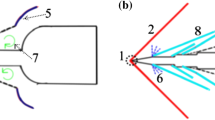Abstract
To explore the influence of the traveling wave parameters on the aerodynamic characteristics of Ahmed models, the geometric model of the traveling wave wall is used as the study object, and the influence of the traveling wave geometric parameters on aerodynamic drag is studied by numerical simulation. A cosine-type traveling wave digital model is established on the basis of Ahmed’s original model. Results show that the static traveling wave structure can play a good role in reducing drag under some driving conditions. The traveling wave’s drag reduction characteristics are affected by the layout position, depth, wavelength, and other related parameters and more affected by driving speed. Finally, a group of working conditions with good drag reduction effects is selected, and the principle of drag reduction by using static traveling wave structure is explained qualitatively and quantitatively through velocity field, shear stress, and pressure field.
Similar content being viewed by others
Abbreviations
- A D :
-
The orthographic projection area of the object (m2)
- C D :
-
Aerodynamic drag coefficient
- F D :
-
Aerodynamic resistance of the object in the direction of movement
- L :
-
The length of the plate (m)
- Q :
-
Vorticity equipotential surface
- Re :
-
Reynolds number
- S :
-
Strain rate amplitude
- V ∞ :
-
The relative speed of the synthetic airflow (m/s)
- Ω :
-
Vorticity amplitude
- ρ :
-
Air density (kg/m3)
- δ(L) :
-
Thickness of the boundary layer of the flat plate (m)
References
Editorial Department of China Highway Journal, Chinese automotive engineering academic research review 2017, Chinese Journal of Highways, 30(6) (2017) 1–197.
Y. C. Zhang, H. N. Cao and H. Zhu, Research on aerodynamic drag reduction of GTS model based on plasma, Journal of Hunan University (Natural Science Edition), 46(8) (2019) 51–58 (in Chinese).
J. Peng, Study on the Bionic Drag Reduction Characteristics of Automobile and Train Shape, Taiyuan: School of Mechanical Engineering, Taiyuan University of Technology (2018) 3–10.
Q. Y. Wang, W. P. Huang, C. G. Lai, X. J. Zhu and Y. Wang, Study on aerodynamic drag reduction of a heavy truck based on aerodynamic accessories, Automotive Engineering, 42(6) (2020) 746–752.
J. C. Zhang, Trailing wave drag reduction and noise reduction coating for submersible, Ship Mechanics, 5(2) (2001) 1–4 (in Chinese).
X. Wei, Q. Z. Li and X. Feng, Numerical study on the suppression of the oscillating wake of a square cylinder by a traveling wave wall, International Journal for Computational Methods in Engineering Science and Mechanics, 20(1) (2019) 48–63.
G. Y. Sun, E. Y. Chen and A. L. Yang, Aerodynamic performance of concave and convex leading blade and numerical study of flow field around it, Thermal power Engineering, 34(4) (2019) 127–134 (in Chinese).
W. Wang et al., Suppression of cylindrical vortex-induced vibration on the surface of trailing wave microstructure, Journal of Harbin Engineering University, 39(11) (2018) 18–23 (in Chinese).
P. Lin, Research on Aerodynamic Drag Reduction of Flexible Non-smooth Surface Coupling, Hangzhou: School of Mechanical Engineering, Zhejiang University (2017) 62–71 (in Chinese).
R. Liu, Study on Aerodynamic Drag Reduction Characteristics of Variable Curved Trailing Wave Surface, Hangzhou: School of Mechanical Engineering, Zhejiang University (2016) 13–42 (in Chinese).
X. Feng et al., Flow control of the wake vortex street of a circular cylinder by using a traveling wave wall at low Reynolds number, Computers & Fluids, 145 (2017) 52–67.
J. C. R. Hunt, A. A. Wray and P. Moin, Eddies, streams, and convergence zones in turbulent flows, Center for Turbulence Research, Proceedings of the Summer Program 1988 (1988) 193.
S. R. Ahmed, Some salient features of the time-averaged ground vehicle wake, SAE Paper (1984) 840300.
X. J. Hu, Automotive Aerodynamics, Beijing: People’s Communications Press (2014) 5–80 (in Chinese).
C. C. Zhang, Research on Flow Field Control and Drag Reduction of Biomimetic Non-smooth Surfaces, Changchun: College of Biology and Agricultural Engineering, Jilin University (2007) 17–51 (in Chinese).
J. Y. Wang, S. S. Zhou and X. J. Hu, Numerical simulation of backstep flow under plasma control, Journal of Chongqing University of Technology (Natural Science), 33(2) (2019) 62–67 (in Chinese).
H. L. Guo, Research on Aerodynamic Characteristics, Stability and Following Characteristics of Vehicles in Queue, Nanning: School of Mechanical Engineering, Guangxi University (2019) 22–49.
Q. Peng, Parameter Optimization of Turbulent Boundary Layer Drag Reduction Control Based on Plasma Exciter, Shenzhen: Shenzhen Research Institute of Harbin Institute of Technology (2018) 6–14 (in Chinese).
Acknowledgments
Great acknowledgement to the National Natural Science Foundation of China (No.51875238) for supporting this work.
Author information
Authors and Affiliations
Corresponding author
Additional information
Wei Lan is a Professor of the College of Automotive Engineering, Jilin University, Changchun, China. Her research interests include aerodynamics, heat transfer, and nanofluids.
Rights and permissions
About this article
Cite this article
Hu, X., Wang, Z., Li, J. et al. Aerodynamic drag reduction based on static traveling wave structure. J Mech Sci Technol 36, 2379–2386 (2022). https://doi.org/10.1007/s12206-022-0420-3
Received:
Revised:
Accepted:
Published:
Issue Date:
DOI: https://doi.org/10.1007/s12206-022-0420-3




